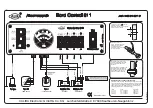
6V&12V Serials
11
12
1. The voltage in above table is at 25°C.
2. Please contact the manufacture about standard for normal power supply or tough power supply.
3. Above are standard setup parameters in table 3-1. We suggest you to set up end voltage (BLVD)
based on different load current to make the battery life longer. Please refer to table 3-2.
Table 3-2 Voltage setup parameter of BLVD and LLVD
I<0.025C
10
0.025C
10
≤I<0.05C
10
0.05C
10
≤I<0.1C
10
0.1C
10
≤I<0.2C
10
0.2C
10
≤I<0.5C
10
1.97
1.92
1.87
1.83
1.75
47.3
46.1
44.9
44
42
47.3
46.1
45.6
45.6
45.6
Load current(A)
BLVD for 48V
system(V)
LLVD for 48V
system(V)
End voltage(V/cell)
|
Operation Condition
Acme, AcmeG, MP, MPG, GP, GPG, HRL, 12REXC, ICS, UDS, DT serials
Ambient temperature: optimum temperature is 15°C~25°C, the higher and lower temperatures will
impact battery performance.
HTB, HTB-F Serials
Ambient temperature: Acme series optimum temperature is 15°C~35°C, the higher and lower
temperatures will impact battery performance.
Ambient humidity: ≤95%
Cabinet ventilation conditions: meet the standard EN 50272-2:2001
Table 3-3 Operation temperature range
Table3-4 Operation temperature range
Discharge
Charge
Storage
Discharge
Charge
Storage
-40°C~50°C
-20°C~50°C
-20°C~40°C
-40°C~65°C
-20°C~65°C
-20°C~45°C
15°C~25°C
15°C~25°C
15°C~25°C
15°C~35°C
15°C~35°C
15°C~35°C
Operation status
Operation status
Optimum temperature
Optimum temperature
Temperature range
Temperature range
|
Capacity and influence factors
The capacity can be expressed in Rated Capacity or Actual Capacity. The Actual Capacity is the
product of discharge current (A) and discharge time (h). The usual unit of capacity is ampere-hour,
shortened as Ah.
The Influence Factors of Actual Capacity
The actual capacity is mainly related with the battery’s construction, manufacturing process and
operation circumstance. During operation, the factors are discharge rate, end voltage and ambient
temperature.
Discharge Rate
If the discharge rate (hour rate) is smaller, the discharge current is larger, and the discharge duration
is shorter, then the capacity, which can be discharged, is less. For example, the discharge current
of 3 hours rate is larger than that of 10 hours rate; and the capacity of 3 hours rate is smaller than
that of 10 hours rate.
End Voltage
The end voltage is the lowest working voltage below which the battery cannot be discharged any
more. Usually the end voltage of 6V & 12V range battery is 10.8V per block. The capacity cannot be
discharged more even if the end voltage drops, because of the characteristics of lead acid battery.
The lower end voltage will harm the battery, especially when the voltage drops to 0V and the battery
cannot be recharged in time. It will shorten the life of the battery greatly.
Summary of Contents for 6V Series
Page 12: ...6V 12V Serials ...































